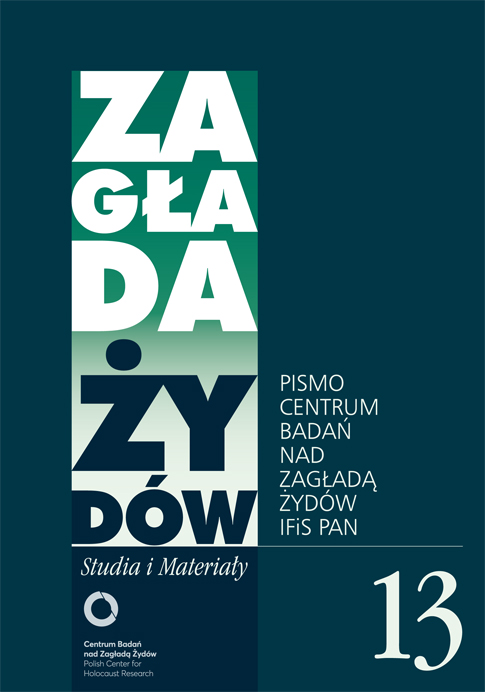Bernard Mark, powstanie w getcie warszawskim i proces Jürgena Stroopa
Zagłada Żydów. Studia i Materiały, Nr 13 (2017), Strony: 181-202
Data zgłoszenia: 2020-10-17Data publikacji: 2017-12-03
 https://doi.org/10.32927/ZZSiM.356
https://doi.org/10.32927/ZZSiM.356
Abstrakt
Jürgen Stroop, the SS general who led the liquidation of the Warsaw Ghetto and the suppression of the Warsaw Ghetto Uprising in April–May 1943, was convicted by a Polish court in 1951 and executed in 1952. Bernard (Ber) Mark (1908–1966), Holocaust historian and director of the Jewish Historical Institute in Warsaw, provided expert testimony for the prosecution at Stroop’s trial. Mark felt constrained to graft a communist-inflected narrative onto his account of the Warsaw Ghetto Uprising and to shoehorn it into his expert testimony in court and then into his interpretation of the trial for a Jewish audience. He did his best to give the Jewish Fighting Organization, which spearheaded the uprising, and its Jewish fighters their due at a time when expression of unvarnished appreciation for Jewish heroism was risky, even while he was paying overrated tribute to the communist underground for its assistance to the Jewish rebels during the uprising. But he always stopped short of the line between conformity to and defiance of the communist regime
Słowa kluczowe
Bernard Mark , Żydowski Instytut Historyczny , powstanie w getcie warszawskim , proces Jürgena Stroopa
Licencja
Prawa autorskie (c) 2017 Autor&"Zagłada Żydów. Studia i Materiały"

Utwór dostępny jest na licencji Creative Commons Uznanie autorstwa 4.0 Międzynarodowe.
https://creativecommons.org/licenses/by/4.0
Czasopismo publikowane jest w standardzie Diamond Open Access na licencji CC-BY-4.0 Deed - Uznanie autorstwa 4.0 Międzynarodowa - Creative Commons
Inne teksty tego samego autora
- Gabriel Finder, Proces Szepsla Rotholca a polityka kary w następstwie Zagłady , Zagłada Żydów. Studia i Materiały: Nr 2 (2006)
- Gabriel Finder, Svenja Bethke, Dance on the Razor’s Edge:Crime and Punishment in the Nazi Ghettos [Gabriel N. Finder] , Zagłada Żydów. Studia i Materiały: Nr 17 (2021)
Podobne artykuły
- Zofia Wóycicka, W poszukiwaniu trzeciej drogi. Nowa wystawa stała w Muzeum Żydowskim w Berlinie (część „Katastrofa”) , Zagłada Żydów. Studia i Materiały: Nr 19 (2023)
- Dariusz Libionka, Barbara Engelking, Od Redakcji , Zagłada Żydów. Studia i Materiały: Nr 20 (2024)
- Barbara Engelking, “Germans have killed our Jews, so we’re getting rid of them.” The case of Edward Toniakiewicz , Zagłada Żydów. Studia i Materiały: Nr Holocaust Studies and Materials (2017)
- Jerzy Kochanowski, Żydowskie listy do Hansa Franka (1940): sprzeciw czy strategia przetrwania? , Zagłada Żydów. Studia i Materiały: Nr 9 (2013)
- Barbara Engelking, The Memoir of Doctor Chaim Einhorn, a Physician from a Warsaw Ghetto Hospital , Zagłada Żydów. Studia i Materiały: Nr Holocaust Studies and Materials (2017)
- Michał Głowiński, Mordechaj Chaim Rumkowski – postać rzeczywista i bohater legend , Zagłada Żydów. Studia i Materiały: Nr 9 (2013)
- Tom Navon, Avinoam J. Patt, The Jewish Heroes of Warsaw: The Afterlife of the Revolt , Zagłada Żydów. Studia i Materiały: Nr 20 (2024)
- Katrin Stoll, Rozkład jazdy tylko w jedną stronę. Przesłuchania byłych urzędników Reichsbahn na temat deportacji Żydów z Prużan do Auschwitz w 1943 r. , Zagłada Żydów. Studia i Materiały: Nr 12 (2016)
- Maria Ferenc, Aleksandra Bańkowska, „Czy może być jakieś odszkodowanie moralne za zatarcie wszelkich śladów tysiącletniego istnienia Żydów w Polsce?” Nieznane pisma Emanuela Ringelbluma z 1943 r. , Zagłada Żydów. Studia i Materiały: Nr 20 (2024)
- Bożena Szaynok, Sine ira et studio... Wspomnienie o Krystynie Kersten , Zagłada Żydów. Studia i Materiały: Nr 4 (2008)
<< < 1 2 3 4 5 6 7 8 9 10 11 12 13 14 15 16 17 18 19 20 21 22 23 24 25 26 27 28 29 30 31 32 33 34 35 36 37 38 39 40 41 42 43 44 45 46 47 48 > >>
Możesz również Rozpocznij zaawansowane wyszukiwanie podobieństw dla tego artykułu.
 English
English
 Język Polski
Język Polski



 https://orcid.org/0000-0003-2829-3979
https://orcid.org/0000-0003-2829-3979

